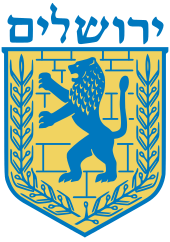Ras al-Amud
Ras al-Amud (Arabic: راس العامود) is a Palestinian neighborhood in East Jerusalem,[1] located southeast of the Old City, overlooking Silwan to the south, Abu Dis and al-Eizariya to the east, and the Temple Mount (known to Arabs as Haram ash-Sharif) to the north.[2] There were about 11,922 Palestinians living in the neighborhood in 2003.[3]
Landmarks
The Judea and Samaria police headquarters was located in Ras al-Amud before moving to a new building near Ma’aleh Adumim in 2008. The property was transferred to the Bukharan Community Committee, which owned the building before 1948.[4]
Neighborhoods
Ma'ale ha-Zeitim is a Jewish neighborhood in Ras al-Amud.[5] A century ago, the property was purchased from the Ottoman government by Nissan Bak and Moshe Wittenburg, who, in turn, transferred the land to Jewish seminaries. The seminaries leased to Arab farmers for the purpose of raising wheat for the production of Passover matza.[6]
During the Jordanian occupation of East Jerusalem, the land was administered by the Jordanian Custodian of Enemy Property. In 1951, an Arab tenant farmer was successful in having the Jordanian Land Registration Office re-register the property in his name, but litigation to reverse the re-registration was ongoing when Jordan lost control of East Jerusalem in the Six Day War in 1967. Following the war, the seminaries pursued the case in Israeli courts until 1984, when the Israeli Supreme Court ruled in their favor. In 1990, the seminaries sold the land to a Jewish American, Irving Moskowitz.[7]
In September 1997, plans for the construction of a Jewish neighbourhood on the land provoked an international outcry. Despite American pressure to halt construction, the plan was backed by Jerusalem mayor Ehud Olmert.[8] Under a compromise reached by Prime Minister Benjamin Netanyahu, three Jewish families left the voluntarily, with ten yeshiva students staying on.[9]On October 18, 2009, the Israeli bus cooperative Egged launched a bus route from Ras al-Amud and Ma'ale HaZeitim to Silwan and the Kotel. Critics claimed this was an attempt to "normalize" the Jewish presence. [10]
In 2011, 100 families were living Ma'ale HaZeitim.[11]
Archaeology
An archaeological excavation in Ras al-Amud prior to the construction of a school for Arab girls by the Jerusalem Municipality found remains dating to the Middle Canaanite period (2200-1900 BCE) and the late First Temple period (8th-7th centuries BCE), including a jar handle inscribed with the Hebrew name "Menachem."[12]
In August 2004, a salvage excavation was conducted in the Ras al-Amud neighborhood in the wake of damage to an ancient building while preparing a site for construction. Ceramic finds dating to the Byzantine period included bowls, a cooking pot and a complete lamp. Glass vessels from the Late Byzantine–Umayyad period were also found. Fragments of ceramic pipes, a marble chancel screen and a stone table were recovered from the stone collapse and soil fills. The building is thus believed to have belonged to a Byzantine monastery.[13]
References
- ↑ Shragai, Nadav (2008-01-16). "Building begins on new Jewish homes in E. J'lem's Ras al-Amud neighborhood". Haaretz. Retrieved 15 March 2010.
- ↑ Israeli Settlement Activities and Related Policies, Jerusalem Palestinian Academic Society for the Study of International Affairs
- ↑ Ras Al Amoud Neighborhood: A hot spot in occupied East Jerusalem Applied Research Institute - Jerusalem and Land Research Center - Jerusalem. 2003-06-23.
- ↑ Ras el-Amud construction begins
- ↑ Five controversial Jewish neighborhoods in East Jerusalem Christian Science Monitor
- ↑ Ras al-Amud: Analysis
- ↑ Ma'aleh Har Hazeitim or Ras el-Amud: The true story, Israel National News, Yedidya Atlas, 1999-07-21.
- ↑ Building begins on new Jewish homes in Ras al-Amud, Haaretz
- ↑ Compromised on Ras al-Amud
- ↑ Jewish residents in Silwan, Ras al-Amud get new bus line. Abe Selig, Jerusalem Post
- ↑ Jerusalem panel approves 14 new Jewish homes in Arab neighborhood
- ↑ An Ancient Jar Handle Bearing the Hebrew Name Menachem was Uncovered in Ras el-'Amud
- ↑ Archaeology News
Coordinates: 31°46′16.95″N 35°14′36.9″E / 31.7713750°N 35.243583°E

.jpg)